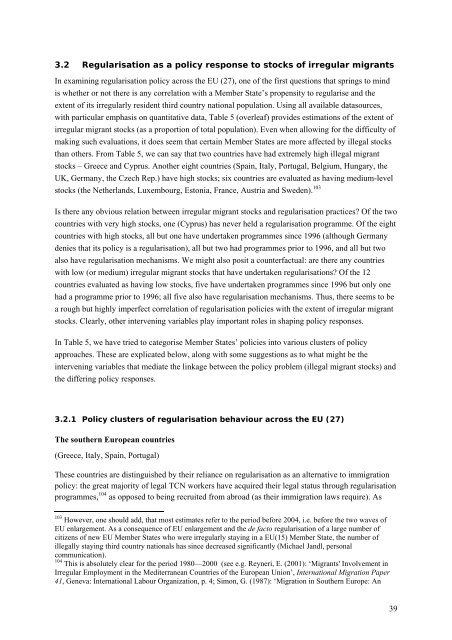REGINE Regularisations in Europe Final Report - European ...
REGINE Regularisations in Europe Final Report - European ...
REGINE Regularisations in Europe Final Report - European ...
Create successful ePaper yourself
Turn your PDF publications into a flip-book with our unique Google optimized e-Paper software.
3.2 Regularisation as a policy response to stocks of irregular migrants<br />
In exam<strong>in</strong><strong>in</strong>g regularisation policy across the EU (27), one of the first questions that spr<strong>in</strong>gs to m<strong>in</strong>d<br />
is whether or not there is any correlation with a Member State’s propensity to regularise and the<br />
extent of its irregularly resident third country national population. Us<strong>in</strong>g all available datasources,<br />
with particular emphasis on quantitative data, Table 5 (overleaf) provides estimations of the extent of<br />
irregular migrant stocks (as a proportion of total population). Even when allow<strong>in</strong>g for the difficulty of<br />
mak<strong>in</strong>g such evaluations, it does seem that certa<strong>in</strong> Member States are more affected by illegal stocks<br />
than others. From Table 5, we can say that two countries have had extremely high illegal migrant<br />
stocks – Greece and Cyprus. Another eight countries (Spa<strong>in</strong>, Italy, Portugal, Belgium, Hungary, the<br />
UK, Germany, the Czech Rep.) have high stocks; six countries are evaluated as hav<strong>in</strong>g medium-level<br />
stocks (the Netherlands, Luxembourg, Estonia, France, Austria and Sweden). 103<br />
Is there any obvious relation between irregular migrant stocks and regularisation practices? Of the two<br />
countries with very high stocks, one (Cyprus) has never held a regularisation programme. Of the eight<br />
countries with high stocks, all but one have undertaken programmes s<strong>in</strong>ce 1996 (although Germany<br />
denies that its policy is a regularisation), all but two had programmes prior to 1996, and all but two<br />
also have regularisation mechanisms. We might also posit a counterfactual: are there any countries<br />
with low (or medium) irregular migrant stocks that have undertaken regularisations? Of the 12<br />
countries evaluated as hav<strong>in</strong>g low stocks, five have undertaken programmes s<strong>in</strong>ce 1996 but only one<br />
had a programme prior to 1996; all five also have regularisation mechanisms. Thus, there seems to be<br />
a rough but highly imperfect correlation of regularisation policies with the extent of irregular migrant<br />
stocks. Clearly, other <strong>in</strong>terven<strong>in</strong>g variables play important roles <strong>in</strong> shap<strong>in</strong>g policy responses.<br />
In Table 5, we have tried to categorise Member States’ policies <strong>in</strong>to various clusters of policy<br />
approaches. These are explicated below, along with some suggestions as to what might be the<br />
<strong>in</strong>terven<strong>in</strong>g variables that mediate the l<strong>in</strong>kage between the policy problem (illegal migrant stocks) and<br />
the differ<strong>in</strong>g policy responses.<br />
3.2.1 Policy clusters of regularisation behaviour across the EU (27)<br />
The southern <strong>Europe</strong>an countries<br />
(Greece, Italy, Spa<strong>in</strong>, Portugal)<br />
These countries are dist<strong>in</strong>guished by their reliance on regularisation as an alternative to immigration<br />
policy: the great majority of legal TCN workers have acquired their legal status through regularisation<br />
programmes, 104 as opposed to be<strong>in</strong>g recruited from abroad (as their immigration laws require). As<br />
103 However, one should add, that most estimates refer to the period before 2004, i.e. before the two waves of<br />
EU enlargement. As a consequence of EU enlargement and the de facto regularisation of a large number of<br />
citizens of new EU Member States who were irregularly stay<strong>in</strong>g <strong>in</strong> a EU(15) Member State, the number of<br />
illegally stay<strong>in</strong>g third country nationals has s<strong>in</strong>ce decreased significantly (Michael Jandl, personal<br />
communication).<br />
104 This is absolutely clear for the period 1980—2000 (see e.g. Reyneri, E. (2001): ‘Migrants' Involvement <strong>in</strong><br />
Irregular Employment <strong>in</strong> the Mediterranean Countries of the <strong>Europe</strong>an Union’, International Migration Paper<br />
41, Geneva: International Labour Organization, p. 4; Simon, G. (1987): ‘Migration <strong>in</strong> Southern <strong>Europe</strong>: An<br />
39
















